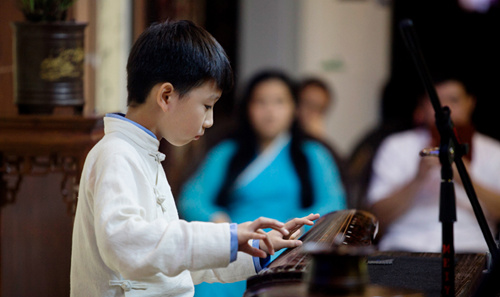Guqin is reborn as a traditional art genre
Author : MENG XIN Source : Chinese Social Sciences Today 2017-06-01

A boy is playing a famous guqin melody Tune for a Peaceful Night at Nanshan Academy in Nanjing.
Guqin, a seven-stringed plucked Chinese instrument much like a zither, was once favored by scholars and the intellectual elite in China. With changes in culture and the decline of certain cultural pursuits, the guqin has gradually fallen out of use. However, a series of events in the early 21st century brought significant changes. In 2003, the art of playing guqin was listed on UNESCO’s list of Masterpieces of Oral and Intangible Heritage of Humanity. In 2008, the entire world heard guqin music at the opening ceremony of the Beijing Olympic Games. Guqin is no longer an art form considered to be too highbrow to be popular among ordinary people.
Difficult past
Modern guqin activities and festivals have proven popular, but the situation was not always this positive. It is said that in the 1950s, there were fewer than 100 people who could play guqin throughout the whole country.
Even after the reform and opening-up, very few people played guqin. Yao Liang, a disciple of Guangling guqin master Gong Yi and manager of Chunfeng Guqin Club, the first guqin club in Shenzhen, said: “Although the current number of people who play guqin is continuously rising and now stands at around 20,000 to 30,000, the guqin is still not in popular demand compared to other musical instruments.”
From museums to the masses
Musicologists heatedly debated whether the guqin should be preserved in museums or be used by the masses. The fact that the guqin was listed on the Masterpieces of Oral and Intangible Heritage of Humanity and performed at Beijing Olympic Games proves that there is no reason why the guqin should only be considered a form of art kept in museums.
The guqin master Gong once wrote that at the start of the 1950s, government departments began to pay attention to and support the dying guqin music. Zha Fuxi and other old guqin masters made great effort to introduce guqin music, organize materials of the guqin legacy and pass down their guqin skills to students. They organized a number of documents with millions of characters, which promoted the theoretical study of guqin music. In 1956, the Central Conservatory of Music, Shanghai Conservatory of Music and other conservatories set up the guqin major and trained approximately 20 students majoring in guqin music. These students later grew up into a new generation of guqin professionals. They not only inherited past traditions of guqin music, but also broke new ground for the development of guqin in modern life.
Revival of guqin
Since 1979, a series of research societies or clubs for guqin music have been established in many cities throughout the country, including Nanjing, Chengdu, Shenyang, Yangzhou and Hangzhou. These organizations contribute to expanding and enriching the art of guqin.
In 2010, guqin was introduced to elementary and secondary schools. Since then, the Department of Intangible Heritage Protection of the Ministry of Culture and China Intangible Heritage Protection Center have co-organized many large activities to introduce guqin masters and guqin melodies to school campuses, aiming to pass down traditional artistic legacy to children, a country’s future. In addition, many universities in the nationwide set up guqin clubs or associations. In the Guqin Club of Peking University alone, there are more than 400 members. For the guqin, which used to be favored only by ancient scholars, the development of guqin clubs on today’s campuses is an incredible step.
Ye Shengtao made Chinese fairy tales from a wilderness
Ye Shengtao (1894–1988) created the first collection of fairy tales in the history of Chinese children’s literature...
-
How northern ethnicities integrated into Chinese nation
2023-09-18
-
Mogao caves
2023-09-12
-
Mogao Grottoes as ‘a place of pilgrimage’
2023-09-12
-
Time-honored architectural traditions in China
2023-08-29
-
Disentangling the civilizational evolution of China
2023-08-28
-
AI ethics in science fiction
2023-08-23














 2011-2013 by www.cssn.cn. All Rights Reserved
2011-2013 by www.cssn.cn. All Rights Reserved